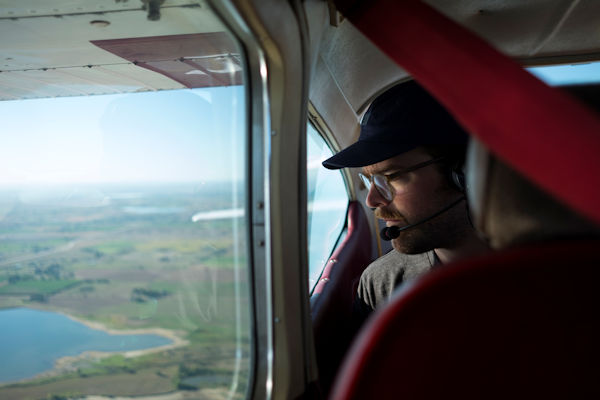SEJournal Online is the digital news magazine of the Society of Environmental Journalists. Learn more about SEJournal Online, including submission, subscription and advertising information.
 |
| Award-winning radio reporter Luke Runyon, above, was lauded by SEJ for his coverage of water in the West. Photo: Nick Cote. Click to enlarge. |
Inside Story: Radio Reporter Takes Listener on Journey in Covering Future of Western U.S.
Public radio reporter Luke Runyon's comprehensive coverage of Colorado River Basin issues, called “timely and compelling” by judges in the Society of Environmental Journalists 2019 Annual Awards for Reporting on the Environment, won him honorable mention in the small market outstanding beat reporting category. SEJournal’s Inside Story editors recently caught up with Runyon. Here is the conversation.
SEJournal: How did you get your winning story ideas?
Luke Runyon: My beat is the Colorado River, and there's been no shortage of news in the watershed. The story in the basin is always one of scarcity, of there not being enough water to satisfy everyone's needs. The stories I submitted [for the SEJ award] look at how this scarcity drives decision-making on arguably the world's most heavily managed river system — whether a landmark multi-state agreement to force water delivery cutbacks earlier, a program designed to give endangered fish species a fighting chance of survival or the desperate attempts to force more moisture from snowstorms in the form of cloud seeding. Each story idea started as a small nugget and, like most western water stories, grew into something much meatier and more existential over the course of my reporting.
SEJournal: What was the biggest challenge in reporting the pieces and how did you solve that challenge?
Runyon: Water stories in the American West can be endlessly fascinating, if you're given enough background and history to make sense of them. The challenge on this beat is finding a way to make the stories accessible and compelling without weighing them down with too much exposition. Water, and who or what is given access to it, is integral to the future of the West, with its growing populations and rising temperatures. Stripping away the jargon and legalese to get at the root of a story ends up being the biggest challenge in taking a story from idea to broadcast.
Even the most complex water issues can be
distilled down to the story of a single person,
or a handful of people, and their motivations.
SEJournal: What most surprised you about your reporting?
Runyon: I'm always surprised at how even the most complex water issues can be distilled down to the story of a single person, or a handful of people, and their motivations. Water in the West can feel like an impenetrable topic, even for this beat reporter, and I love finding out that you can make sense of them by talking to the right people and peeling back a few bureaucratic layers.
SEJournal: How did you decide to tell the stories and why?
Runyon: Looking through the list of SEJ award winners, I'm one of a handful of audio-focused storytellers, which lends itself well to environmental reporting. My editor, Brian Larson at KUNC, is always encouraging me to get into the field, gather interesting sound and paint a picture for the listener. With each of these stories I wanted to bring them along with me, out into the world to talk to these different characters and visit places they may never get to otherwise. Taking the listener on a journey is always in the back of my mind when I'm structuring a story and doing the in-field reporting.
SEJournal: What would you do differently now, if anything, in reporting or telling the stories and why?
Runyon: There are always more perspectives to include, and while I try to explore each story from different angles, inevitably some get left out. Looking back at these pieces there are voices that would've more fully rounded out each of them. It's a good reminder to always be checking yourself on where the blind spots are and making sure to eliminate them in future reporting.
SEJournal: What lessons have you learned from your story or project?
Runyon: These stories have shown me how powerful a story can be when it tries to answer one simple question. It can be easy to fall into a trap of overcomplicating an issue. But when you're driven by a singular straightforward question, the end result is stronger for it.
SEJournal: What practical advice would you give to other reporters pursuing similar stories, including any specific techniques or tools you used and could tell us more about?
Runyon: Not sure if this is the most groundbreaking practice, but in the course of doing a story, keep a little notebook of any and all questions you were unable to answer during the reporting process. I keep a small notebook of tangential questions to the story at hand and will return to it frequently to figure out what I should be covering next. It's been a treasure trove and I think all beat reporters would benefit in keeping track of lingering issues and questions that can be so easy to forget when the daily churn kicks in.
Luke Runyon reports on the Colorado River basin and western water issues for NPR member station KUNC in northern Colorado, and for a network of public radio stations in the southwest. He frequently files stories for NPR’s Morning Edition, All Things Considered, Weekend Edition and APM's Marketplace. Runyon has also reported for Harvest Public Media, Aspen Public Radio and Illinois Public Radio. He has a master’s degree in public affairs reporting from the University of Illinois Springfield.
* From the weekly news magazine SEJournal Online, Vol. 6, No. 10. Content from each new issue of SEJournal Online is available to the public via the SEJournal Online main page. Subscribe to the e-newsletter here. And see past issues of the SEJournal archived here.













 Advertisement
Advertisement 



